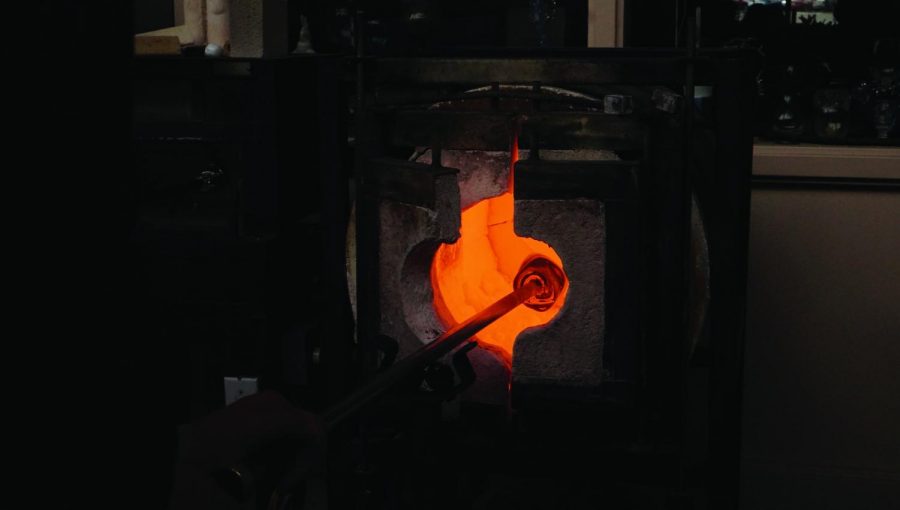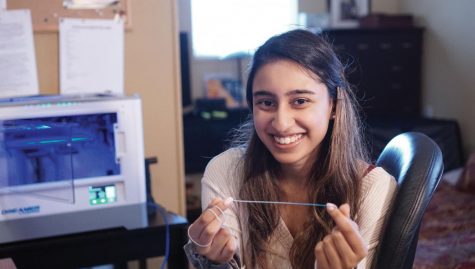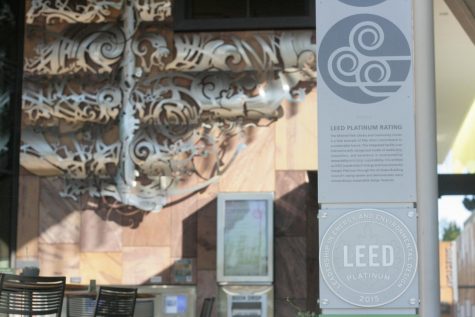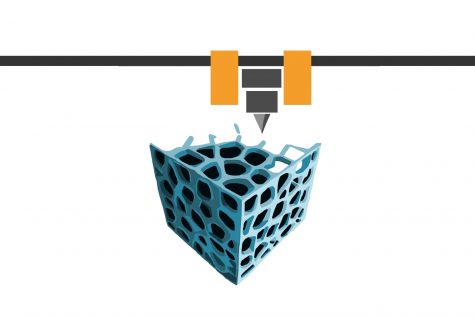All About That Glass
The material behind the class
The gathered clear glass wrapped around the purple center is lifted into the gloryhole. The glass taken out of the main furnace must be kept hot in order to retain its malleability. (Photo by Kaitlyn Khoe)
Shaping superhot glass with surprising confidence, first year Palo Alto High School sophomore glassblower Eli Crystal begins the steps for his twisty canes.
These twisty canes start with four short purple rods, lined up on a ceramic plate and slid into the gloryhole, a small reheating furnace. The rods are then painstakingly melded into a plate.
When the colored center is deemed hot enough, Crystal pulls clear glass out of the furnace, where it is kept at 2300°F. In its molten state, the glass glows a bright orange and is stringy like cheese.
Maintaining consistent temperature is critical in glassblowing because of its poor heat conductivity. If the outside of the glass touches something cold, it shrinks slightly. However, the inside is still warm, generating stress in the glass that can cause cracking. The metal poles used to gather glass are kept over open flame, so both the metal and the glass aren’t shocked with a dramatically different temperature.
Alternating rolling with heating, Crystal forms a base and attaches the plate. The glass cools from a hot orange to a duller red. What follows is a process of gathering, molding and reheating until the glass forms a symmetrical cylinder.
Crystal and his partner sophomore Tucker McBride pull the cane apart with a twisting motion, careful not to let the rapidly cooling glass touch the cold cement. The pulled cane is laid over a flat wooden ladder, the top charred black from previous projects.
In 50 minutes, Crystal and McBride have turned viscous glass into a six foot long clear pole. In the center, the former purple rods have twisted into long strips spiraling up and down the entire length. The helix inside looks vaguely like DNA.
“I feel glassblowing is more technical and physical than traditional art and that’s why I like it,” Crystal said.
Glass is a highly versatile medium. Its trademark properties come from its random molecular, or amorphous, structure. Because of this, the definition of glass is much broader than its classic use. In fact, even some hard candies are considered glass.
“Every specific kind of glass discipline has a specific recipe,” said Paly’s ceramics teacher Steven Ferrera, who has more than 22 years of glassblowing experience under his belt. “The formula for soft glass and glass blowing is a little bit different [than other glass].”
Typically, the glass used in glassblowing is a “soft glass” or silica glass. It retains its malleability much longer than industrial glasses like borosilicate, a glass whose extreme durability comes from addition of the element boron and makes up the beakers and flasks used in laboratories.
The manufacturing of glass is a detailed process of balancing materials, trying to retain glass’ essential properties.
Silica, which composes 70 percent of glass, goes by several names. Technically, it’s silicon dioxide. In layman’s terms, it’s quartz, silica and sometimes just glass. It contributes gives glass its stability, and increases its melting temperature.
To reduce its melting temperature, manufacturers add sodium carbonate. However, adding sodium carbonate causes the resulting product to be water soluble, which is less than ideal in a building material. To counteract this, manufacturers also add lime, or calcium oxide.
Although the age-old skill of glassblowing will always remain a classic, the future of glass art of might drift in the same direction many other industries — 3D printing.
In 2015, Massachusetts Institute of Technology’s Mediated Matter group introduced its take on 3D printed glass. Instead of printing with a glass powder like previous experiments, the Mediated Matter group used molten glass, enabling a greater control over shape and color.
MIT’s scientists envision their printer, called G3DP after “Glass 3D Printing,” as a bright future for optical lenses. Their glass carries the durability and transparency of industrial silica glass, without the brittle crumbling traits of earlier attempts.
“I’ve seen people — normal people, not scientists — 3D print glass,” Ferrera said. “The technology is there. If somebody wanted to and was proactive enough to figure it out, then it’s totally possible.”




